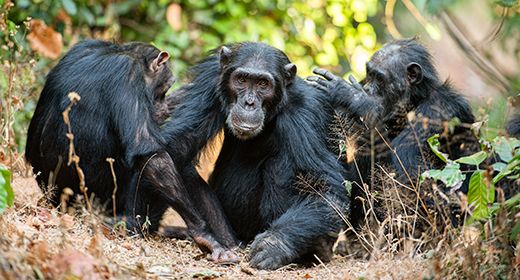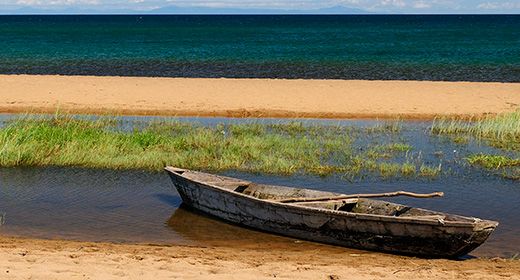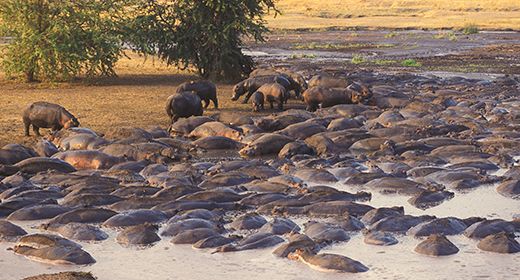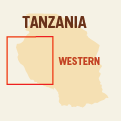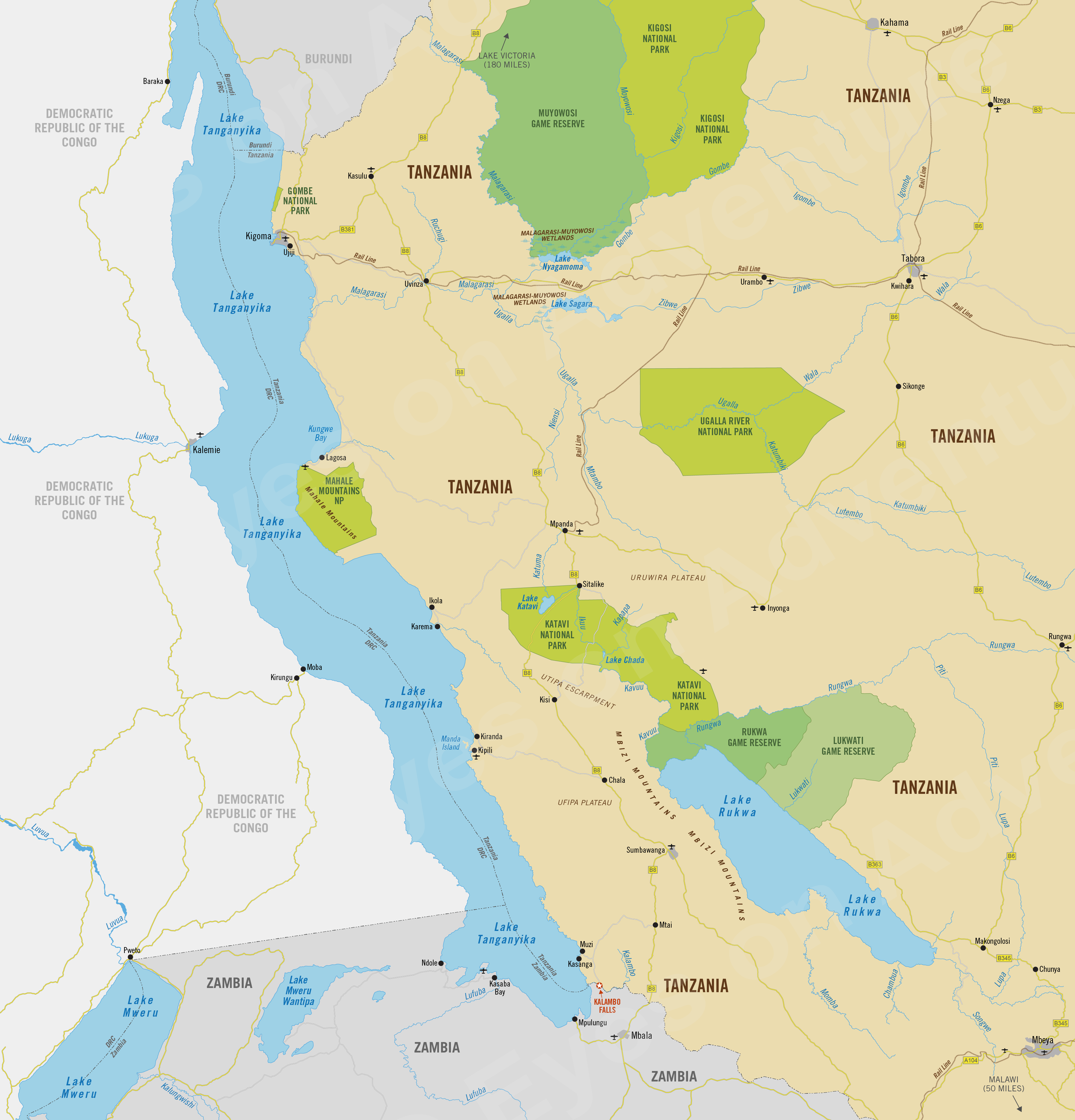Western Tanzania
(incl. Lake Tanganyika, Mahale Mountains, Gombe, Katavi)
Region Links: Great Migration, Kilimanjaro & Arusha, Ngorongoro & Manyara, Serengeti, Southern Tanzania, Tarangire, Western Tanzania, Zanzibar
Highlights
- Gombe National Park for chimpanzees and other primates
- Mahale Mountains National Park for chimp trekking and some large mammals
- Katavi National Park offers superb dry-season big-game safaris
- Lake Tanganyika is Africa's second-largest freshwater lake
EOA Recommends: Chada Katavi, Gombe Forest Lodge, Greystoke Mahale
Remote Western Tanzania is dominated by Lake Tanganyika along Africa's Great Rift Valley. Gombe National Park, made famous by Jane Goodall, offers chimpanzee trekking, as does Mahale National Park. Katavi National Park boasts excellent big game safaris.
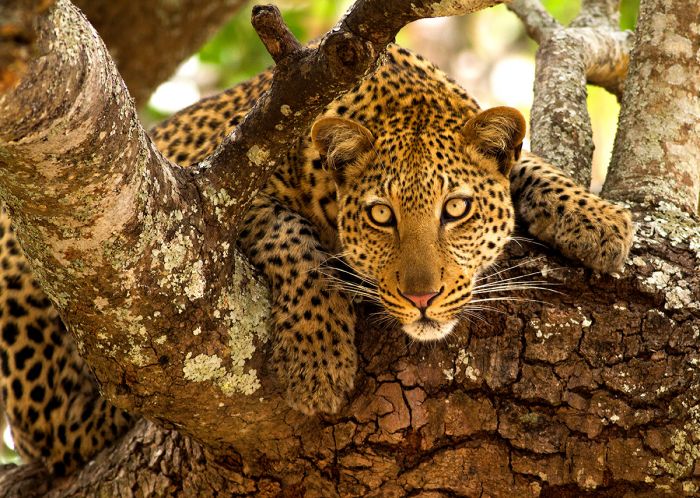
A leopard in a tree in Katavi National Park, Tanzania.
Western Tanzania is a remote destination and requires some time to reach, but this is part of its allure. It is one of only a few places in Africa where one can experience wildlife in a setting like it was before European colonization. Very few people visit this region, so for those who wish to escape the crowds, it is very much a worthwhile destination.
Lake Tanganyika is the world's longest freshwater body and also the second-deepest. Its deep waters and remote location make it one of the cleanest aquatic ecosystems on Earth. The lake is the divider between Tanzania's arid Central Plateau and the rich rain forests of Central Africa. Ujiji, a suburb of bustling port town of Kigoma, was the starting point for much of the Arab-controlled slave trade that led to Bagamoyo and Zanzibar in the 1800s.
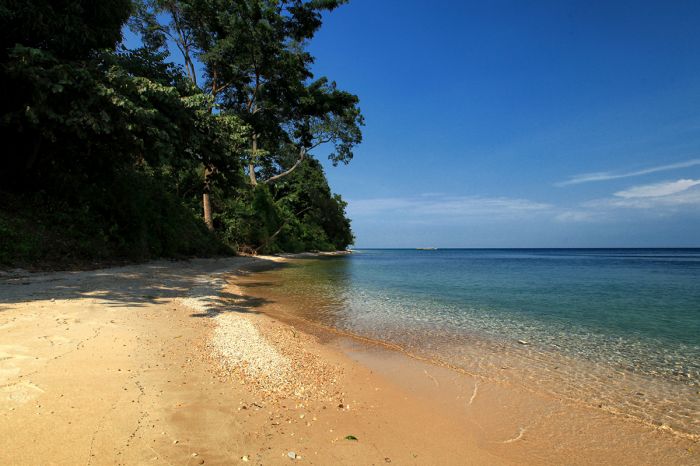
View of Lake Tanganyika in Gombe National Park.
North of Kigoma is Gombe, Tanzania's smallest national park. Gombe gained world-wide attention in the 1960s when Dr. Jane Goodall began a long-term study of chimpanzees in the park. Gombe is not a Big Five safari destination, but it is a rewarding and beautiful park. Chimp trekking is the main activity.
Mahale Mountains National Park is a pristine sanctuary dominated by thick forests and mountainous terrain rising from the shores of Lake Tanganyika. The park offers a huge diversity of habitats that are home to a good variety of mammals, including elephant, buffalo, lion, leopard, giraffe, kudu, and many more. Like Gombe, visits to the park's group of habituated chimpanzees are a highlight.
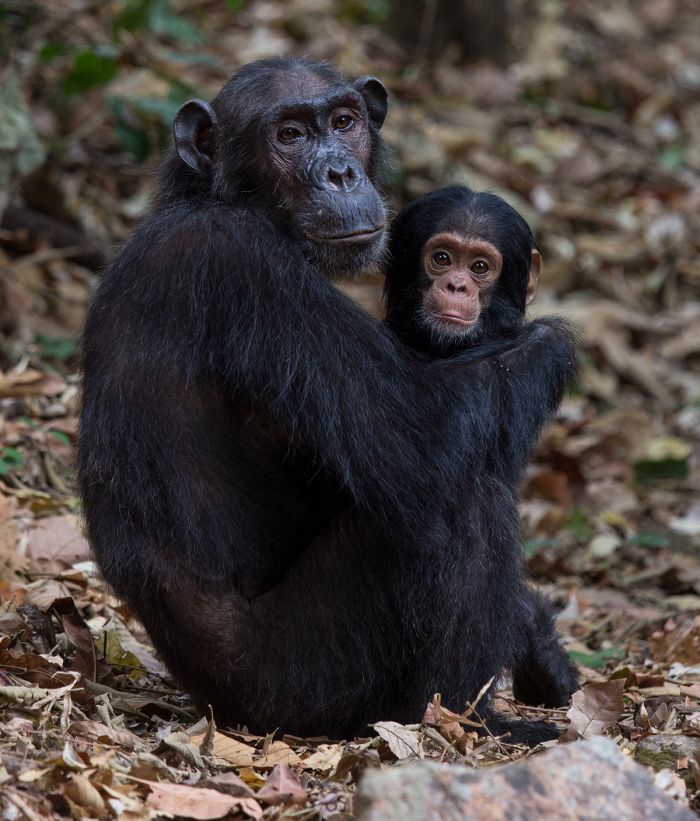
Chimpanzee and her baby in Gombe National Park.
Inland from the lake is Katavi National Park. The park offers spectacular game viewing during the dry season, when huge numbers of buffalo and other herbivores congregate around the receding water sources. Lions are commonly seen, as are elephants, giraffes, zebras, crocodiles, hippos, and a good variety of antelopes. Like all of western Tanzania, Katavi is a seldom-visited wilderness destination free from crowds.
Fly-in safaris are the best way to explore the remote destinations in Western Tanzania. For those yearning for an experience far from the crowds of the popular northern parks, this region is definitely worth adding to your itinerary.
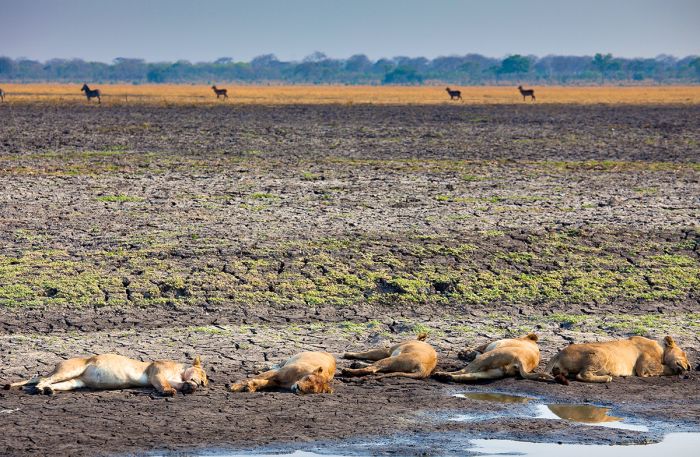
Lions in Katavi National Park, Tanzania.
Read More...
Chimpanzees, Gombe National Park, History, Katavi National Park, Lake Tanganyika, Mahale Mountains National Park
History
Tanzania is believed to be the home for Earth's earliest hominids, with discoveries of early fossil evidence at Olduvai Gorge (in the Ngorongoro region) dating back at least two million years. These prehistoric hunter-gatherer hominids lived in this region of Africa for millennia and were eventually assimilated by pastoralist humans several thousands years ago.

Traditional boat on Lake Tanganyika near Kigoma.
Early ivory and slave traders from Asia and Arabia established settlements along the Indian Ocean coast of East Africa, the most prominent of which was Zanzibar. Eventually, demand for more product led Arab traders inland all the way to Lake Tanganyika in the early 1800s. Slaves were captured across the lake in the Congo Basin and transported across the lake to Ujiji, which was at that time the major lakeshore terminal for all ivory and slave trading in the region.
Over the next fifty years, tens of thousands of shackled African slaves were moved on foot from Ujiji to Tabora and eventually to the Indian Ocean coast. The grueling 750-mile (1200-km) journey from Ujiji to Bagamoyo took between three and six months, and many slaves perished along the way from exhaustion or being shot attempting to escape. Over one million enslaved Africans are thought to have been transported along this important ivory and slave caravan route.
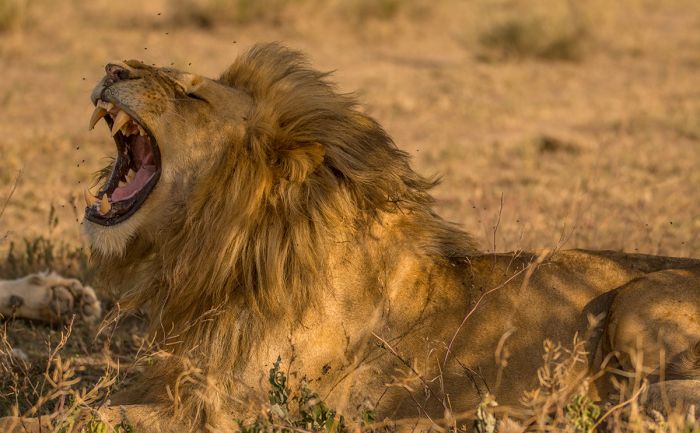
Male lion in Katavi National Park.
The first Europeans to explore western Tanzania were the British team of John Speke and Richard Burton, whose well-documented expedition between 1856-1859 sought to discover the source of the Nile River. The expedition arrived at Ujiji in 1858. Ujiji is also the place where the historic meeting between Henry Morton Stanley and David Livingstone occurred in 1871.
In the 1880s, Germany claimed present day Tanzania as a protectorate known as German East Africa. To facilitate trade from the interior, construction began on the Central Line Railway in 1905 to connect Dar es Salaam on the coast to Lake Tanganyika. The railway follows the old caravan slave route to Tabora and then to Kigoma, which replaced Ujiji as the major port on Lake Tanganyika. The railway was completed in 1914, just prior to World War I.
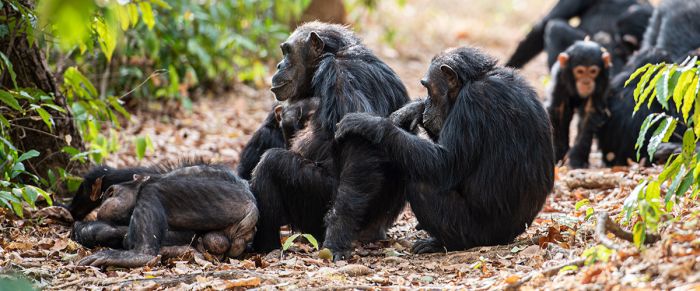
Chimps grooming in Gombe National Park.
During World War I, the British advanced into German East Africa and eventually occupied the country. After the war, Britain received a League of Nations mandate to administer the entire territory except for Rwanda and Burundi, which came under Belgian administration, and the Kionga Triangle (far north Mozambique on the coast), which fell to Portugal. The British-controlled territory was called the Tanganyika Territory, while the Zanzibar Archipelago remained a separate colonial jurisdiction.
Tanganyika gained its independence in 1961 and Zanzibar in 1963 and in 1964, the two entities merged to form the United Republic of Tanzania.
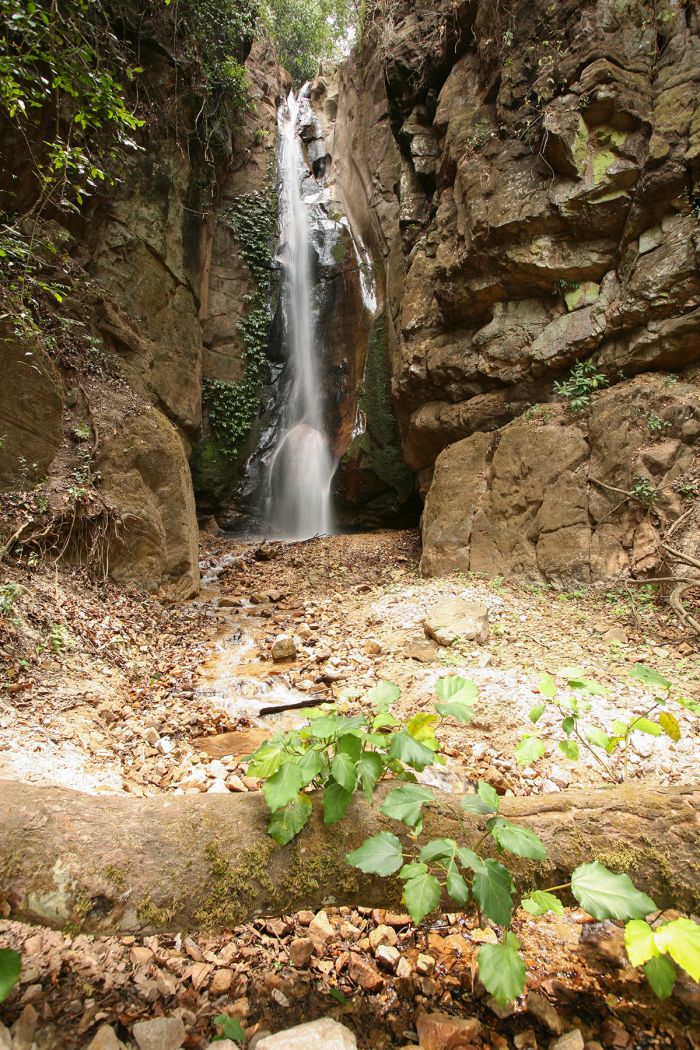
A waterfall in pristine forest, Gombe National Park.
Lake Tanganyika
Lake Tanganyika formed around three million years ago as part of Africa's Great Rift Valley. The lake itself is divided down the middle, forming the boundary between Tanzania and the Democratic Republic of the Congo (DRC). Small portions of the lake belong to Burundi in the north and Zambia in the south. West of the lake are the lush forests of the Congo River Basin, while to the east is the semi-arid Tanzanian Central Plateau.
Statistically, Lake Tanganyika is the Earth's longest freshwater lake, stretching 421 miles (677 kms) from north to south. The lake is also the second-deepest in the world, reaching a maximum depth of 4 826 feet (1 471 meters). Tanganyika is Africa's second-largest lake by surface area (Lake Victoria is the largest), yet because of its great depth, Tanganyika holds seven times the volume of water of Victoria.
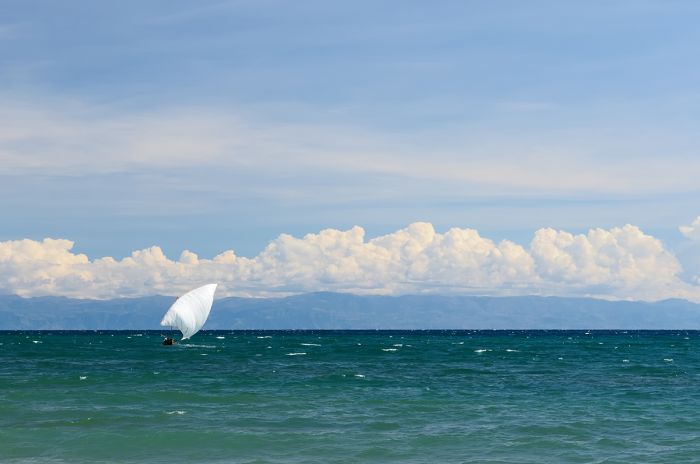
Traditional dhow sailing on Lake Tanganyika, Tanzania.
Lake Tanganyika is fed by over fifty rivers, the largest being the Ruzizi, which flows south from Lake Kivu in Rwanda, and the Malagarasi and Kalambo rivers on the Tanzanian side. The Lukuga River, which flows into DRC only in years of exceptionally high rainfall, is the lake's sole outlet.
Owing to its very long existence and geographic isolation from major human populations, the lake is free from almost any pollution and forms one of the richest and most beautiful aquatic ecosystems on Earth. Over 500 species of fish are found in Tanganyika, of which at least 250 are cichlids, a colorful family of bony fishes that originated in the oceans. Most of Tanganyika's cichlids are endemic to the lake and, like Lake Malawi's cichlids, they are very popular in the aquarium hobby market. The cichlids of the African Great Lakes, including Tanganyika, represent the most diverse example of adaptive radiation in the Earth's vertebrates.
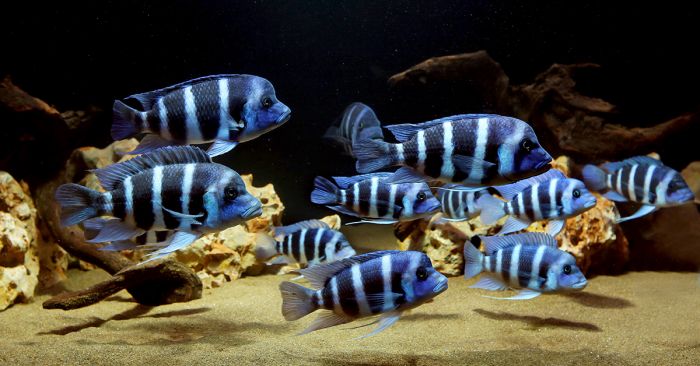
Cyphotilapia frontosa are a cichlid fish from Lake Tanganyika.
The only major settlement on the Tanzanian shore is the town of Kigoma, at the end of the Central Railway from Dar es Salaam. A weekly ferry departs from Kigoma to Zambia, stopping along the way at various small fishing villages. The old Arab slave-trading center of Ujiji lies 6 miles (10 kms) south of Kigoma and is the location of the famous meeting between Stanley and Livingstone, where Stanley spoke the famous line "Dr Livingstone, I presume?"
The main tourist destinations on Lake Tanganyika are two very special and unique national parks located along the shoreline, Gombe and Mahale Mountains. Gombe National Park lies to the north of Kigoma and Mahale Mountains National Park to the south. Both parks are popular for their habituated chimpanzee communities.
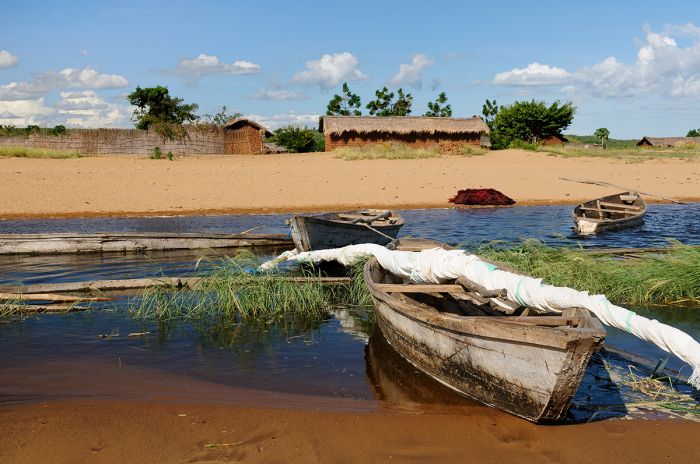
Fishing boats on the beach, Lake Tanganyika.
Gombe National Park
Located 10 miles (16 kms) north of Kigoma on the Lake Tanganyika shoreline, Gombe is one of Tanzania's smallest national parks, covering just 20 square miles (52 sq kms). The park was established in 1968. Infrequently visited, Gombe became a household name internationally during the 1960s when Dr. Jane Goodall began her groundbreaking and well-publicized study of chimpanzees in Gombe in 1960, under the patronage of the Kenyan paleontologist, Louis Leakey.
Gombe covers a thin strip of land comprised of hilly terrain that rises from the lakeshore, interspersed by thirteen river valleys running east-west and upwards to the ridge of the Rift Valley escarpment. The altitudinal variation, combined with lake frontage and multiple rivers, creates a wide range of habitats with diverse flora and fauna. The park is not a place to see Africa's iconic large mammals, but it is spectacular for a variety of primates, including chimpanzees.
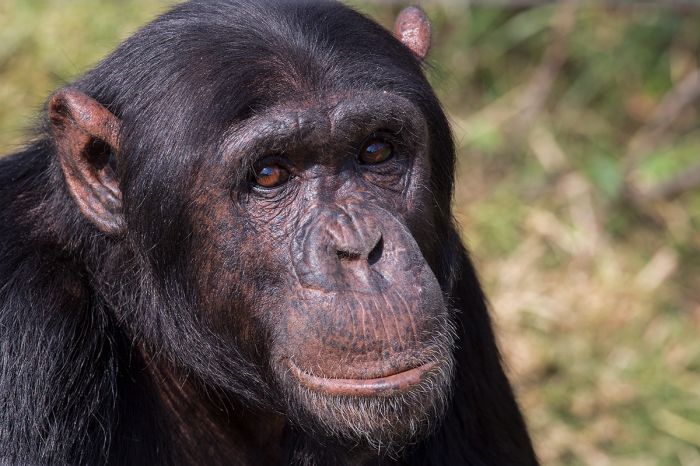
Chimpanzee in Gombe National Park, Tanzania.
There are no roads in Gombe, so hiking and walking are the main activities in the park, especially chimpanzee trekking. In total, the park is home to roughly 100 chimps living in three distinct communities. Guests are able to take guided chimpanzee treks to follow and observe the long-studied and habituated Kasekela community. The Gombe Stream Research Center (GSRC), established in 1967, coordinates ongoing chimpanzee research in the park and this is the world's longest-running field study of an animal species in its natural surroundings.
Chimp treks in Gombe require a degree of fitness, as the terrain is varied and often steep. During the dry seasons (Jul to mid-Oct and mid-Dec to Jan), the chimps tend to forage mostly on the lower slopes of the river valleys, making them easier to reach. In the wet season (mid-Oct to mid-Dec and Feb-Jun), the chimps tend to move to higher elevations for food and walking conditions are more challenging.
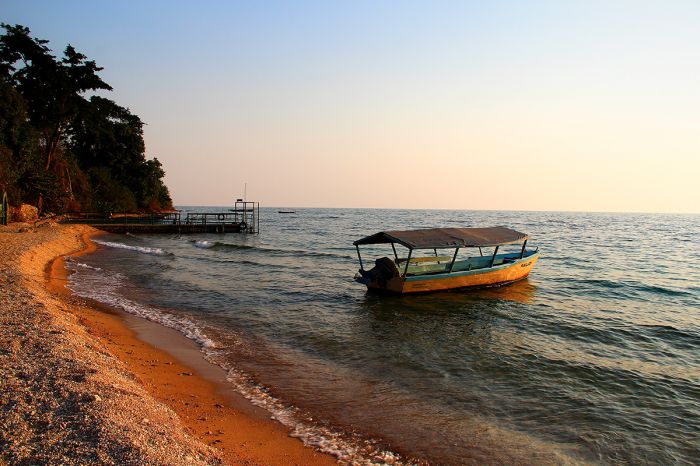
Lake Tanganyika shore at Gombe National Park.
Other primates commonly seen include olive baboon, vervet, red colobus, red-tailed, and blue monkey. Terrestrial mammals include bushbuck and grey duiker. Bird watching is productive, with over 250 species possible.
Gombe is one of the least visited of Tanzania's wildlife refuges, owing mainly to its remote location, which dissuades many tourists. Additionally, while Gombe was once the only reliable place in Africa to see habituated wild chimps, the introduction of chimp-viewing safaris in Uganda have created competition. Getting to Gombe entails a two- to three-hour flight to Kigoma (from Arusha or Dar es Salaam), followed by a boat ride (less than one hour) on the lake to reach the park.
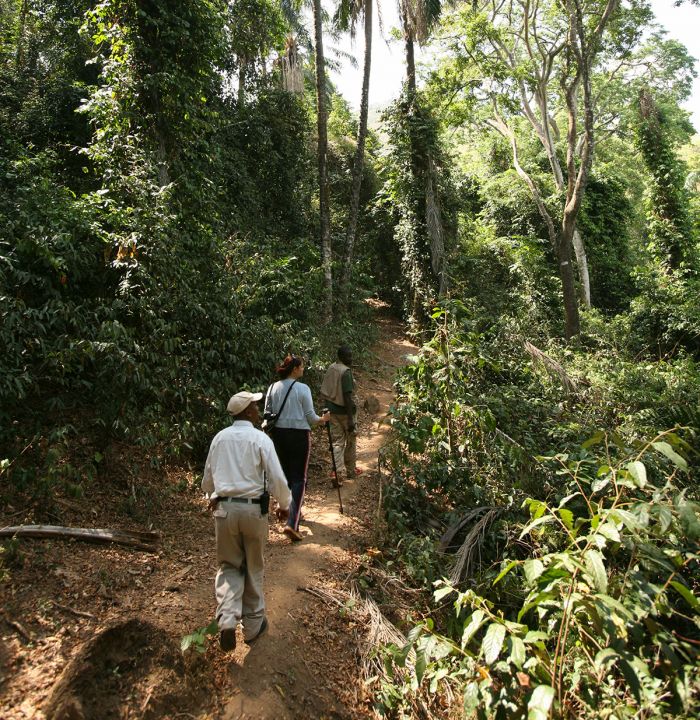
Chimpanzee trekking in Gombe.
Mahale Mountains National Park
Located 75 miles (120 kms) south of Kigoma on a large peninsula extending into Lake Tanganyika, Mahale is the least accessible national park in Tanzania. The park was established in 1985 and covers 623 square miles (1 613 sq kms) of thick forest on the slopes of the imposing Mahale Mountains, which tower over the remote and deserted sandy beaches.
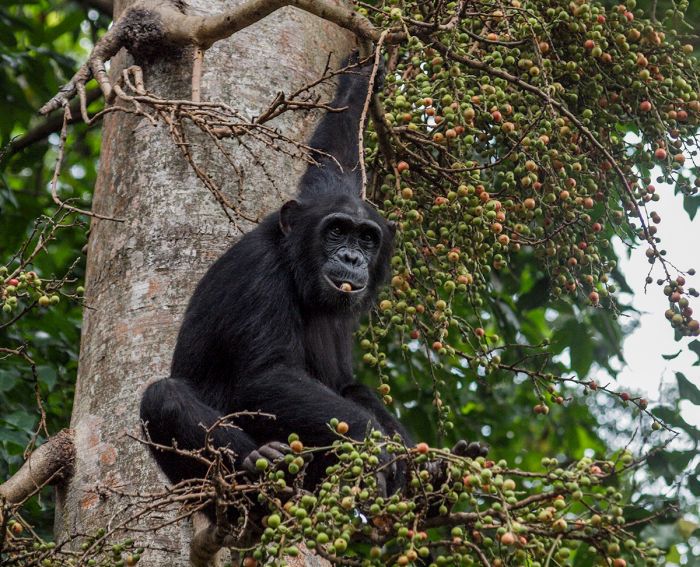
Chimpanzee eating figs in Mahale Mountains National Park.
The park, although thirty times the size of Gombe, is similar to Gombe in many ways, with diverse habitats, including savanna on the eastern side. Mahale has no roads whatsoever, so the eastern side of the park is rarely visited. Like Gombe, chimpanzees are the main draw for visitors, and Mahale's 700-plus chimps are the largest remaining population of wild chimps in the world. The chimps in Mahale have also been the subject of scientific study, with a permanent and ongoing research ongoing since 1961.
Chimpanzee trekking is the main activity offered in Mahale and this means some strenuous hiking on steep and forested trails. Although Mahale has a much larger population of chimps than Gombe, Mahale's size means that locating the chimps may require longer treks. The best time to go for chimps is near the end of the dry season (Jul-Oct), when the chimps tend to stay to the lower slopes of the mountains, sometimes even passing through the safari camps or onto the beach.
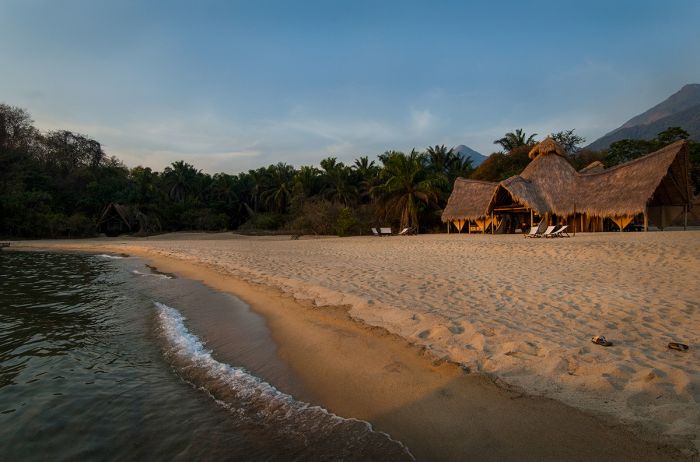
Lake Tanganyika beachfront setting at Greystoke Mahale.
Besides chimpanzees, Mahale is home to a good variety of other primates, including yellow baboon, red colobus, vervet, blue, and red-tailed monkey. An endemic race of black-and-white colobus lives in the higher slopes of the montane forest.
The drier eastern side of the Mahale Mountains lead to a savanna ecosystem, which is home to modest numbers of lion, leopard, African wild dog, spotted hyena, elephant, giraffe, buffalo, zebra, warthog, greater kudu, eland, roan, and sable antelope. The tourist camps are located on the western side of the mountains near the lake, so most of the large mammals are unlikely to be seen, other than warthog and if you're very lucky, leopard. Mahale is notable in that it is the only national park in Africa where lions and chimps coexist. Bird life is excellent, with over 230 species possible.
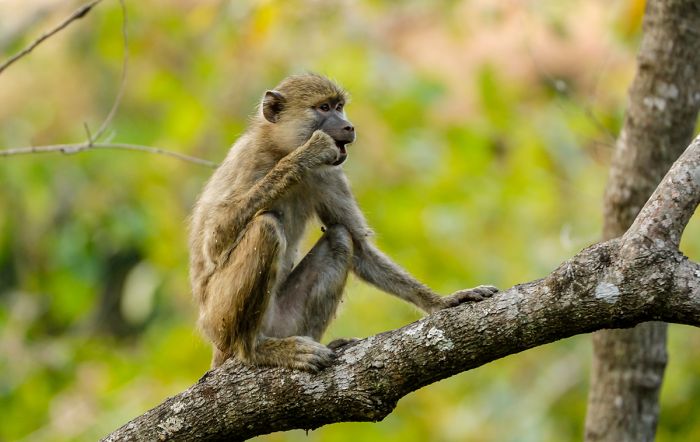
A yellow baboon in Mahale Mountains National Park.
Getting to Mahale is not easy, with no roads into or within the park. There is however a private airstrip in the far north of the park, from which a boat transfer on the lake will bring you to your camp. Charter flights to the airstrip are available from Arusha (3-4 hours), Dar es salaam (2 hours), and Kigoma (30 mins).
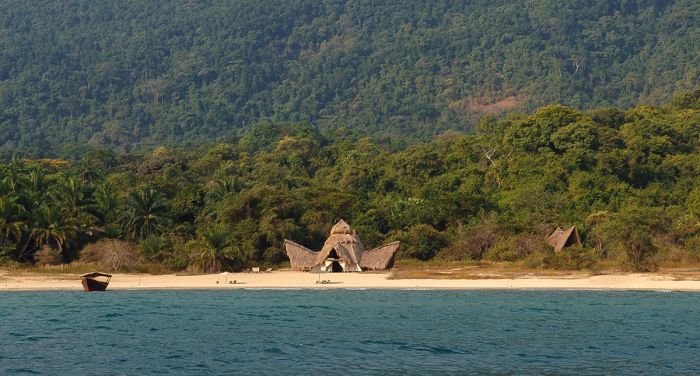
Greystoke Mahale viewed from the lake.
The Chimpanzees of Gombe & Mahale
Most of Tanzania's wild chimpanzees are restricted to two distinct populations, one in Gombe National Park (about 100 individuals) and the other in Mahale Mountains National Park (over 700 individuals). Both populations have been under constant scientific study since the 1960s.
The much larger chimp population in Mahale live in 15 to 20 communities and chimp research has been conducted there by Japan's Kyoto University since 1961. Gombe's chimps, numbering around 100 (down from 150 in the 1970s), gained world-wide acclaim and publicity due to their study by Dr. Jane Goodall beginning in 1960. As in Mahale, the Gombe research continues today.
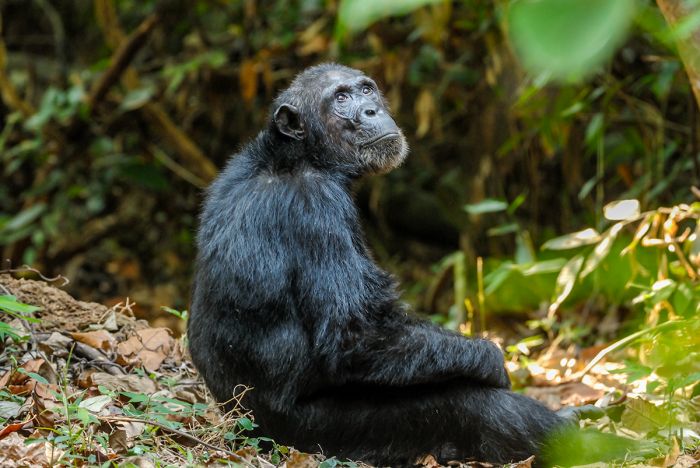
Chimpanzee in Mahale Mountains National Park.
The chimpanzees living in Mahale and Gombe have been geographically separated for a long time and as such, have developed distinct habits and behaviors. Interestingly, the chimps in Gombe regularly eat termites by probing into termite mounds with tools made from sticks. The Gombe chimps seem to relish these termites as a delicacy, but they do not eat ants. The chimps living in Mahale also use sticks to extract insect food, but instead focus on carpenter ants living in the trees, while avoiding termites.
Other notable dietary differences have also been discovered and of the numerous plant species that occur in both parks, roughly 40% are used for food by chimps in one park, but ignored by chimps in the other, and vice versa.
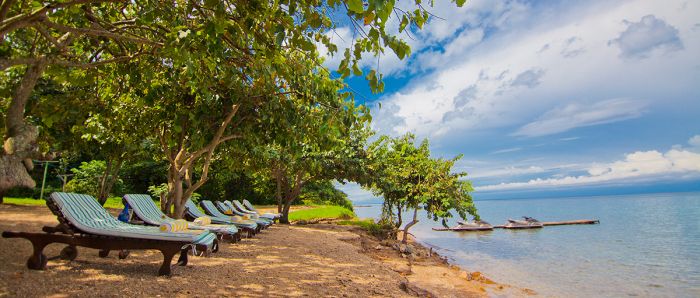
The setting along Lake Tanganyika at Gombe Forest Lodge.
Katavi National Park
Katavi is Tanzania's most remote and least-visited protected big-game destination. Created in 1974, the park covers 1 726 square miles (4 471 sq kms) of savanna, woodland, and seasonal marshland within the Rukwa Rift section of Africa's Great Rift, which culminates at Lake Rukwa south of the park. The Katuma and Kapapa rivers flow seasonally through the park and create life-sustaining pools and small lakes during the rainy months (March/April). These water sources gradually dry up after the rains, but still provide enough water for the park's wildlife to survive through the long dry season.
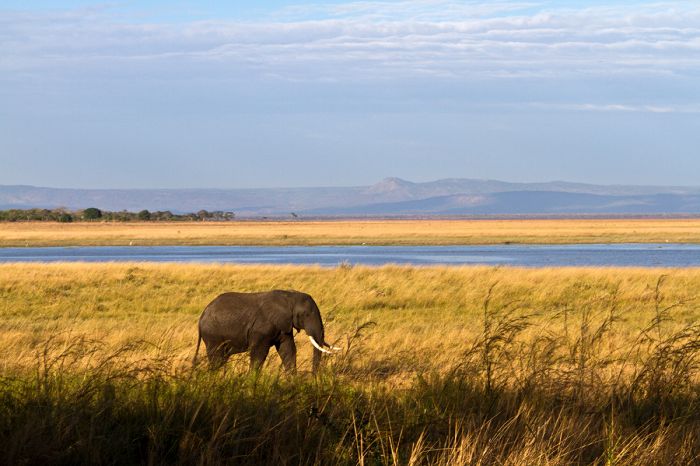
An elephant on the Katisunga floodplain in Katavi National Park.
Game viewing in Katavi is at its best in the latter half of the dry season (Aug-early Nov), when large numbers of buffalo, elephant, zebra, giraffe, hartebeest, topi, impala, reedbuck, and defassa waterbuck converge on the park's floodplains that fringe the seasonal rivers.
Lions are present in good numbers and are often seen around Lake Katavi, Lake Chada, and the rivers. Other predators in Katavi include spotted hyena, African wild dog, leopard, and cheetah. The woodlands are less productive, but contain small populations of eland, roan, and sable antelope.
Katavi supports large numbers of hippos, which are found in massive concentrations (up to 1 000 or more) in the dry season, with males fighting over the dwindling pools of mud and water. Katavi is also home to large numbers of crocodiles. Birding in the park is very good, with over 400 species recorded.
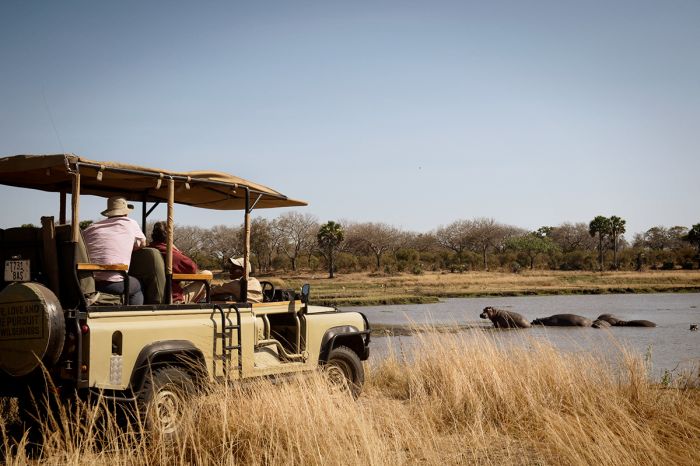
Game drive in Katavi National Park, Tanzania.
Although seasonal in nature, those who have visited Katavi are sure to remark that it must be like Africa was several hundred years ago, before European colonization. It is one of the few places on the continent where one is very likely to see more lions than people.
There are a small number of all-inclusive safari camps to choose from in Katavi National Park. Like the other destinations in Western Tanzania, Katavi is remote and best reached on charter flights from Arusha, Dar es salaam, or one of the parks to the east, such as Ruaha or Selous.
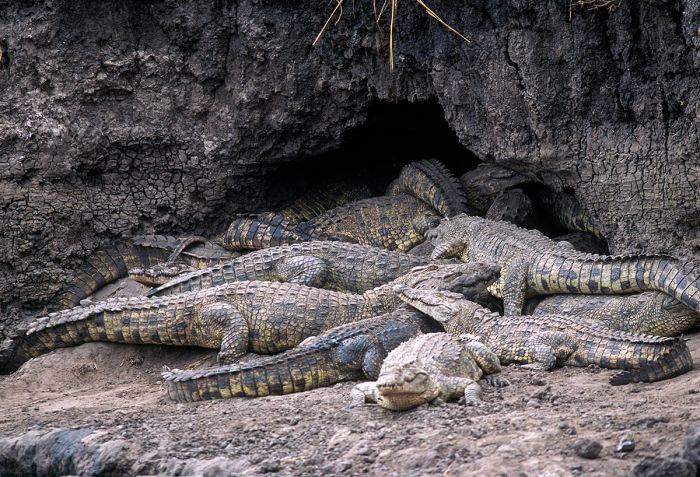
Crocodiles congregate in mud caves, Katavi National Park.
Read More...
Chimpanzees, Gombe National Park, History, Katavi National Park, Lake Tanganyika, Mahale Mountains National Park
Western Tanzania experiences its rainfall from around late October thru December and again from March into May. From mid-May to October, there is a major decline in the rainfall, with almost no precipitation over June, July and August.
Thanks to its position near the equator, daytime temperatures are almost always hot and the days humid. The coolest period is from June to August, when daily highs average 86°F (30°C). The hotter months of December thru February see daytime highs of 90°-93°F (32°-34°C).
Lake Tanganyika experiences a moderate equatorial climate, with warm days throughout the year. Mornings and evenings along the lake can be cool, so a fleece will come in handy.
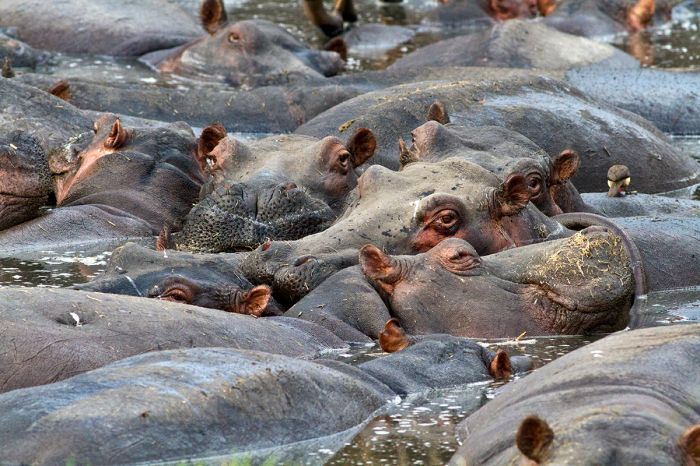
Hippos gather in the Ikuu Springs, Katavi National Park .
Mahale & Gombe
Great Good Fair Poor
- Jan
- Feb
- Mar
- Apr
- May
- Jun
- Jul
- Aug
- Sep
- Oct
- Nov
- Dec
The chimpanzees in Mahale and Gombe are always present but in general, they are easier to see during the dry season (June-September), when they tend to spend more time at lower elevations and closer to the safari camps. During the rainier months (February-May and mid-October to mid-December), the chimps move to higher elevations to take advantage of food sources, which means longer and more challenging treks.
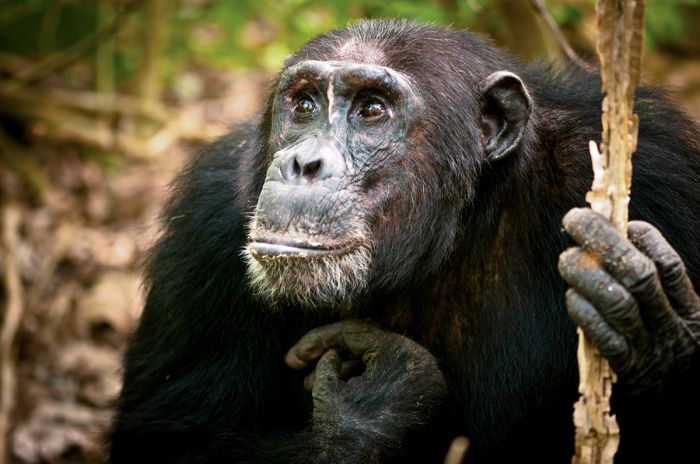
Chimpanzee in Mahale Mountains National Park.
Katavi national park
Great Good Fair Poor
- Jan
- Feb
- Mar
- Apr
- May
- Jun
- Jul
- Aug
- Sep
- Oct
- Nov
- Dec
The best time for wildlife viewing in Katavi is during the dry months of May-October, especially from July onwards. During the rainy months (Nov/Dec and Mar/Apr), much of the park and its vehicle tracks become unusable and many of the the plains game species move outside Katavi's borders into the hills. Also note that tsetse flies are present in Katavi year-round, but are especially prevalent during the rains.
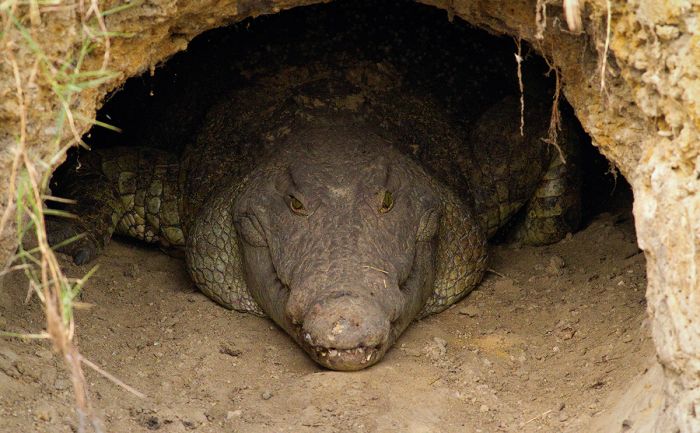
Crocodile in sand cave (dry season), Katavi National Park.




